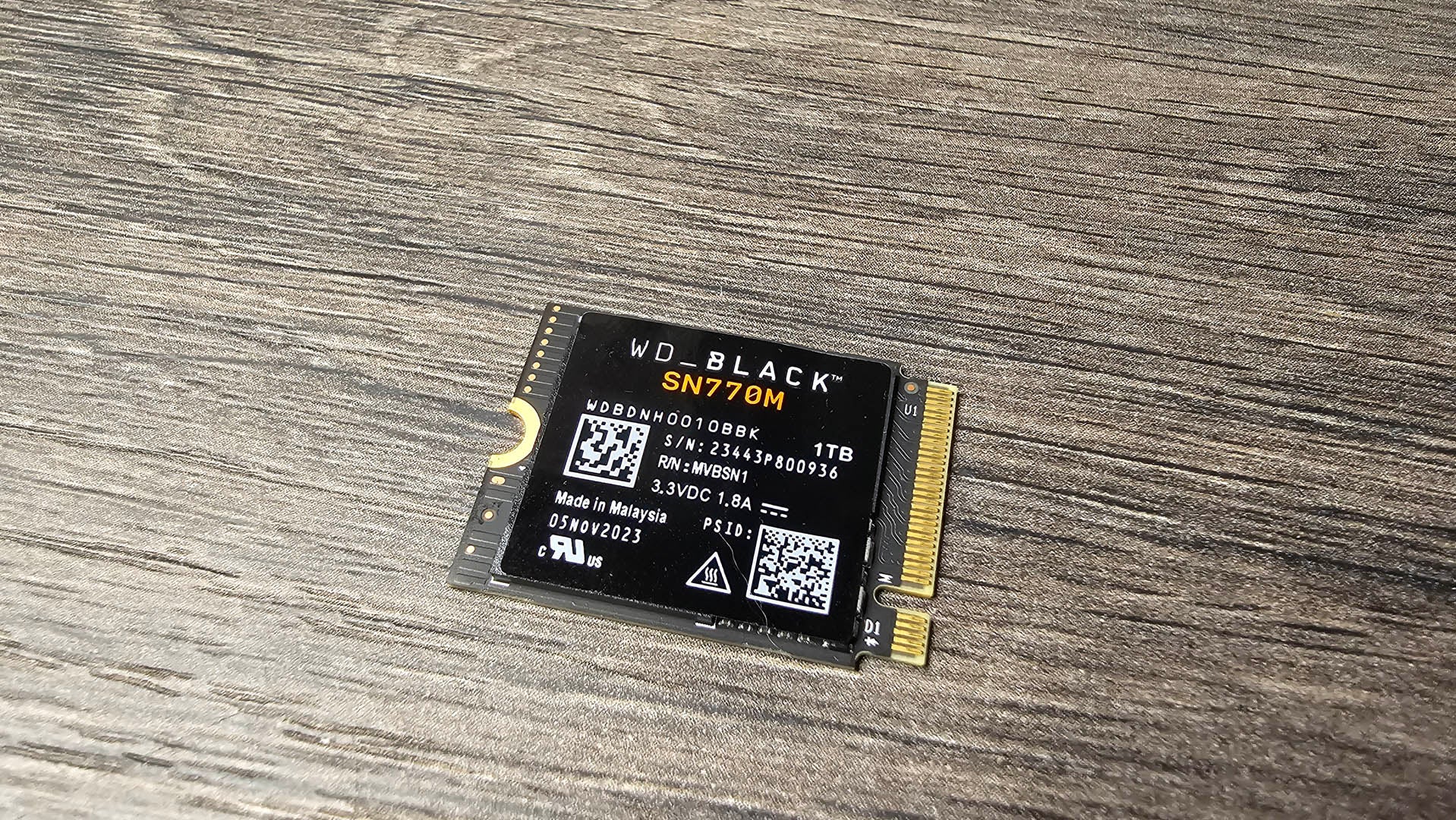Asus ROG Strix Scar 17 X3D Review
The fastest gaming laptop just got faster

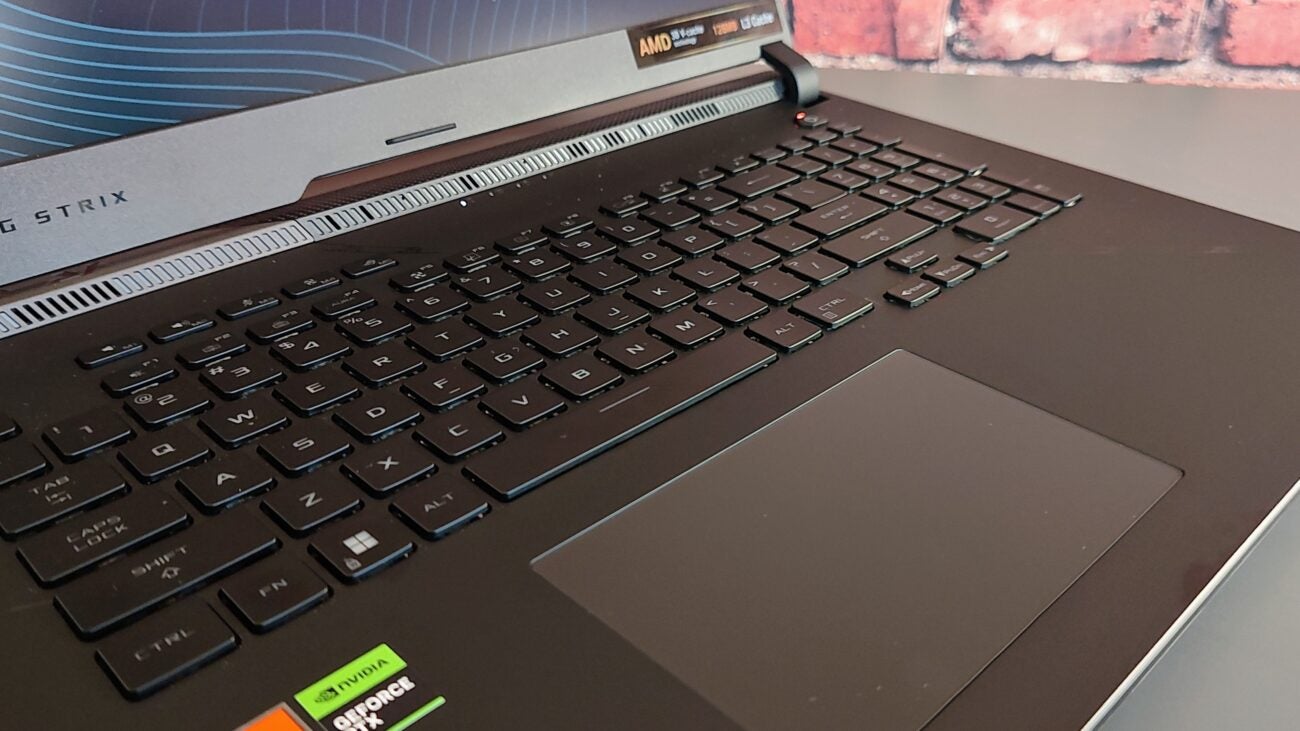
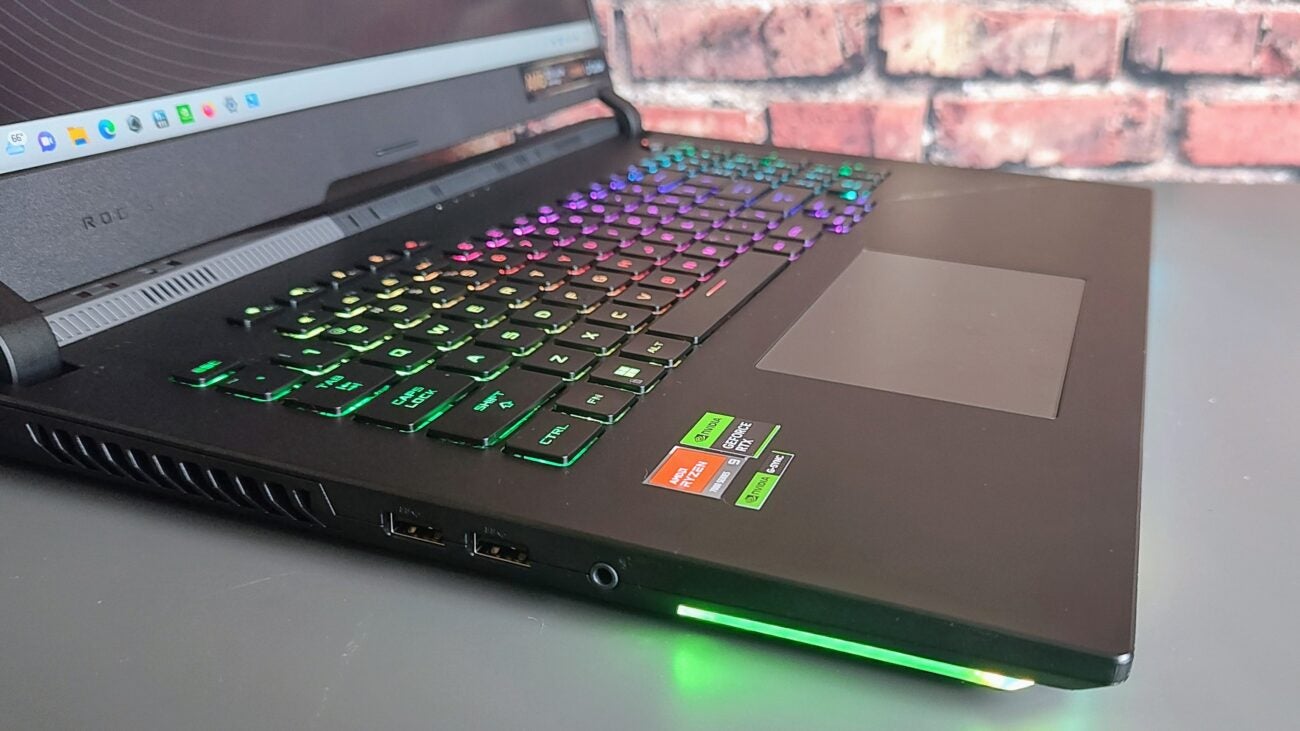
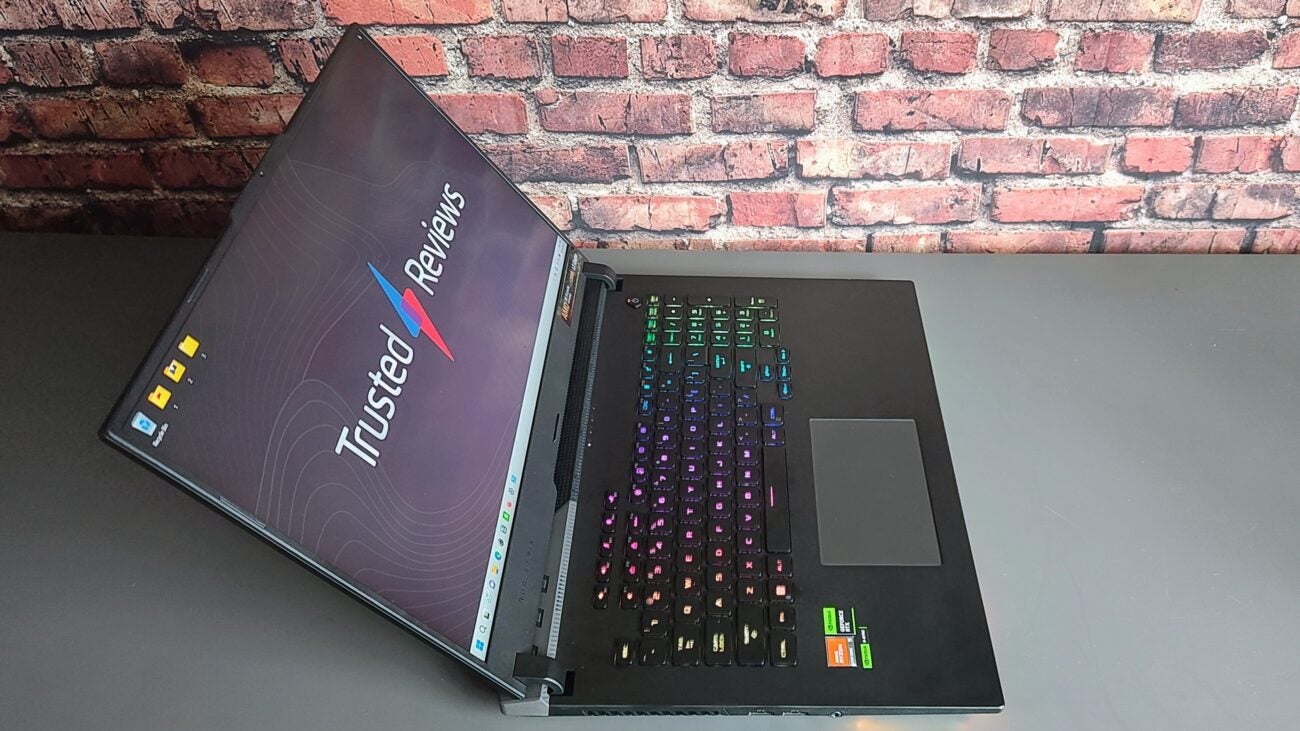
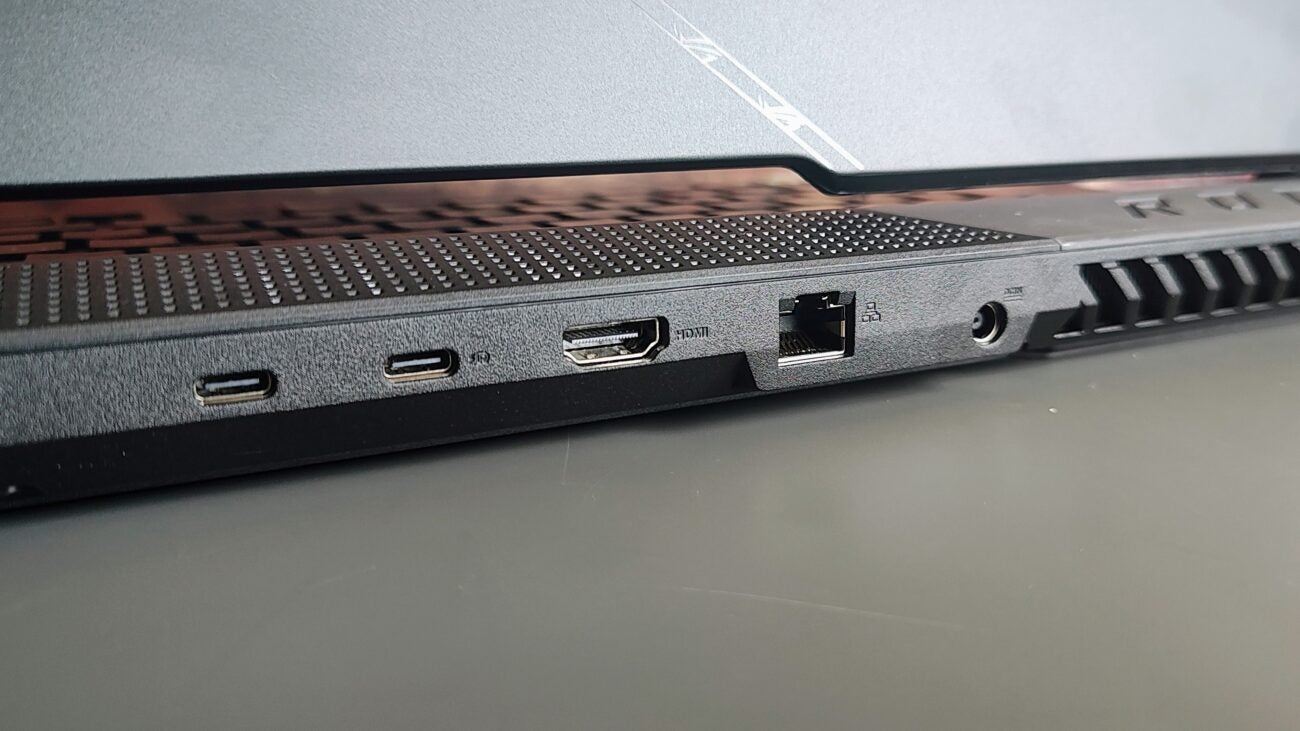

Verdict
Innovative stacked 3D V-Cache makes the Asus ROG Strix Scar 17 X3D even faster in Triple-A games but the basic design is starting to look dated alongside the new Asus ROG Scar Strix 18 models.
Pros
- Even better gaming performance from new 3D V-Cache Ryzen 9 CPU
- Expansive, feature-laden keyboard
- Cool and quiet even under heavy load
Cons
- New CPU only available with premium RTX 4090 GPU
- 720p webcam is a poor effort
- Unbalanced layout of I/O ports
Key Features
- Innovative new CPU designThe new 3D V-Cache version of the AMD Ryzen 9 7945H brings noticeable improvements.
- The basic design is getting oldStill uses the 2021-era design rather than the new Strix Scar 18 look.
- ROG Intelligent CoolingThermal Grizzly’s Conductonaut Extreme liquid metal and Intelligent Cooling for boosted performance.
Introduction
The ROG Strix Scar 17X3D comes with a new variant of AMD’s Ryzen 9 7945HX Dragon Range processor called the 7945HX3D. The 7945HX3D uses what AMD calls “3D V-Cache Technology” to double the amount of L3 cache from 64MB to 128MB compared to the conventional 7945HX. Let’s put it to the test.
The 3D V-Cache packaging technology stacks additional cache layers on top of the CPU, which means you can increase the CPU’s memory without increasing the size of the die or shrinking the logic circuits.
In the case of AMD’s 16-core Ryzen 9 7945HX3D, only one of the 2 blocks of 8 cores gets the additional stacked L3 3D V-Cache because it has a negative impact on clock speed. The 8 cores in the non-3D block run at the same 5.4Ghz boost clock as the 7945HX, but AMD hasn’t released details of the lower maximum boost clock for the 3D V-Cache block.
This design should provide more flexibility, allowing applications that benefit from the additional cache and applications that benefit from higher core clock speeds to run faster. This then should be the best mobile gaming CPU in the world.
Design and Keyboard
- Same basic design as the 2021 and 2022 models
- Chiclet keyboard is solid and well laid out
- Styling is quite subdued for a Strix machine
The new Strix Scar 17 X3D is identical to the Strix Scar 17 I reviewed back in May. It still weighs 3 kg and measures up at 395 x 282 x 28.3mm, which is the same as the 2022 and 2021 models. This is still essentially a 2022 Strix Scar SE with revised silicon.
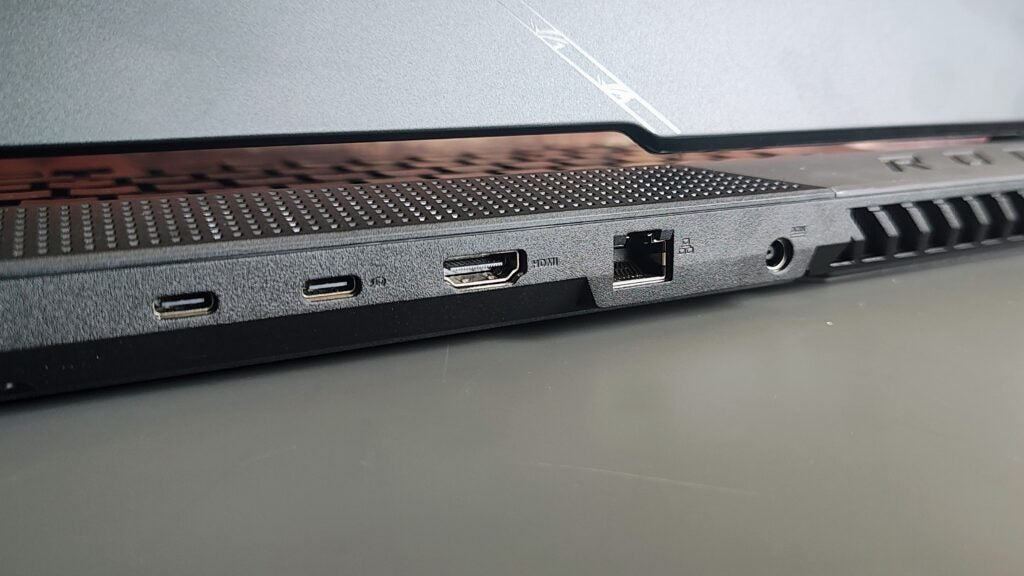
The age of the design to one side, it is still a solid machine made from aluminium and high-quality plastic with only one real fault: fingerprints show up badly on the keyboard deck.
The arrangement of the I/O ports is the same, with two USB-A 3.2 Gen 1 ports on the left side and two Type-C ports (both USB 3.2 Gen 2 spec with DisplayPort video output), HDMI 2.0 and 2.5G LAN ports along with the DC-in and 3.5mm audio jacks at the back. I would prefer data ports on both sides for the Type-A ports to be further apart.
The keyboard is a familiar chiclet affair with 2mm of travel. It’s a solid affair for well suited to serious gaming, though it can’t match the mechanical keyboards fitted to the Medion Erazer Beast X40 or MSI Titan GT77.
The layout is typical ROG which means it’s both comprehensive and expansive though you have to tolerate reduced–size cursor and keypad keys. Five dedicated (and programmable) hotkeys give quick access to features such as the volume, fan speed and the Armoury Crate application. The stylised key-cap graphics are a matter of taste, but they are clear enough.
The RGB lighting is limited to a solid colour or one of twelve preset patterns using only the Armoury Crate control panel. You can set up a per-key lighting arrangement, but it’s far from straightforward. The trackpad measures 130 x 77mm, is perfectly responsive and has a crisp click-action.
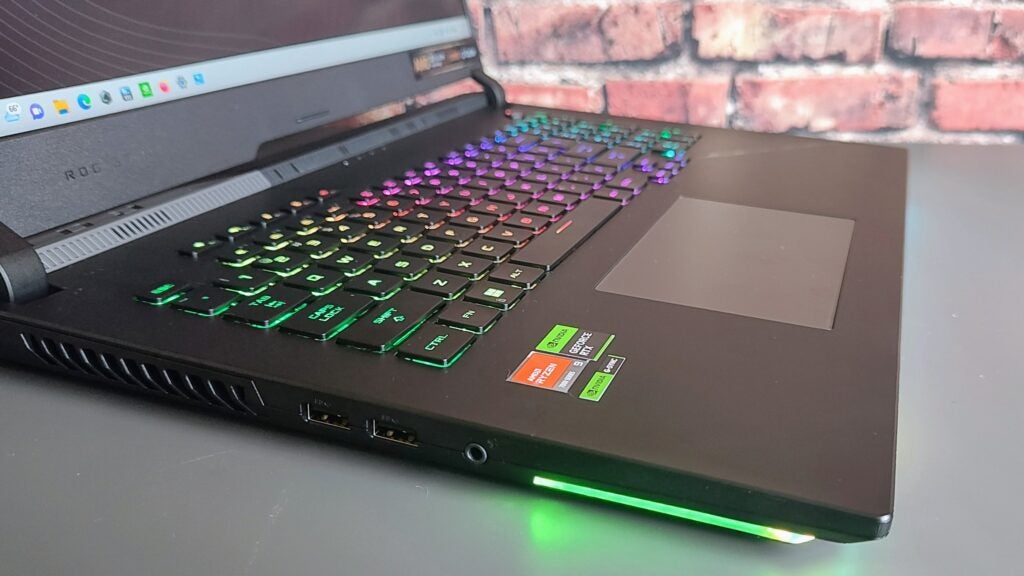
Getting inside the Strix Scar 17 requires care because a ribbon cable connects the lights in the front and side of the base to the motherboard. Once inside, you can easily access the two SODIMM RAM slots, wireless card and two SSD slots.
The 720p webcam is a crude and drab affair, lacking Windows Hello IR facial recognition. In fact, there is no biometric security of any sort, which given the asking price, is taking the proverbial.
Asus makes no claims regarding the amount of recycled material in the ROG Strix Scar 17, but the packaging is free of plastic derivatives.
Display and Sound
- 240Hz 2,560 x 1,440 IPS display
- Wide colour gamut coverage
- Good motion handling
The display is a solid performer with a peak brightness of 348cd/m2 and a decent contrast ratio of 1102:1. There’s plenty of colour available with gamut coverages of 99.9% sRGB, 98.2% DCI-P3 and 84% AdobeRGB while colour accuracy is acceptable with a Delta E of 2.8 vs. the sRGB profile.
It’s been my experience that the ROG Nebula displays fitted to the new Scar Strix 16 and 18 laptops are more colour-accurate.
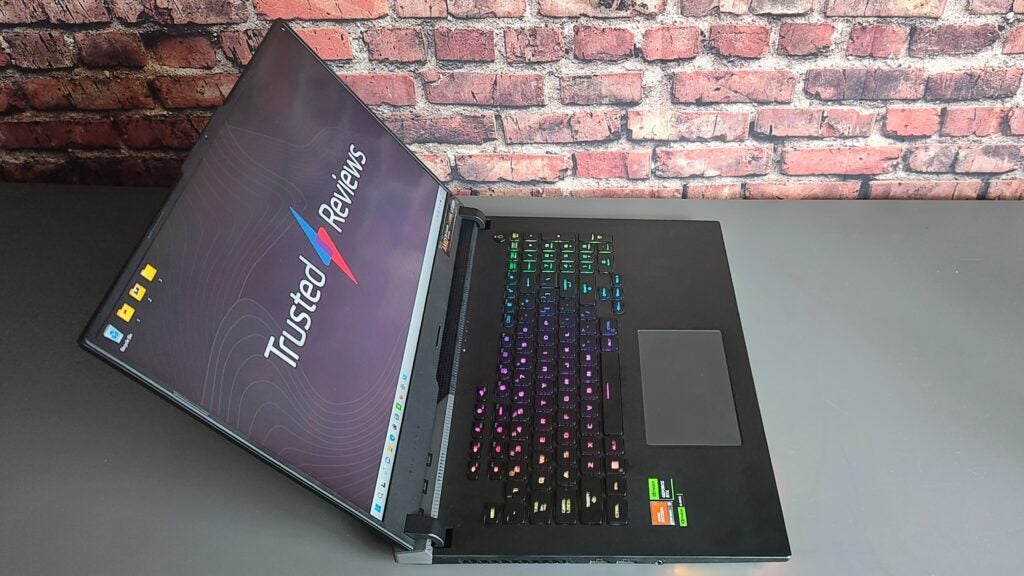
In purely gaming–related terms, the screen ticks all the right boxes. A 240Hz refresh rate and 3ms response time with overdrive keeps ghosting to a minimum, there’s support for Nvidia’s G–Sync adaptive sync technology, and you get Advanced Optimus which acts as a MUX switch without the palaver of having to reboot.
Maximum volume may not be anything out of the ordinary at 72.3dB(A), but the sound the stereo speakers produce is good, with ample bass and good high–frequency reproduction.
Performance
- New 3D V cache delivers impressive gaming performance
- Runs cool and quiet for a hardcore gaming laptop
The X3D incarnation of the Strix Scar 17 uses the same 175W Nvidia RTX 4090 GPU as the regular model, so does the fancy 3D cache CPU make it run games any faster? In a word, yes.
As we’ve changed our testing methodology here at Trusted Reviews since I reviewed the Strix Scar 17, I have focused on the increased performance of the new X3D model vs. the standard Dragon Range machine, which, as we already know, is a very potent gaming platform.
For a direct comparison, I ran three Triple-A gaming benchmarks at 2,560 x 1,440 with ray tracing maxed out and detail levels set to the highest possible with no DLSS upscaling.
On the X3D machine, Metro Exodus ran at 71fps compared to 63fps on the standard 7945HX model. Cyberpunk 2077 ran at 48fps compared to 35fps, while Returnal ran at 101fps compared to 80fps.
Those frame rates were observed under the most demanding settings possible, the sort usually reserved for powerful desktop gaming PCs, not laptops. As you can see from the benchmark scores in the table, those titles will all run two or three times as fast if you forgo ray tracing, drop the resolution to Full HD or engager DLSS.
Less demanding titles like Horizon Zero Dawn don’t need to be dialled back to hit a three-figure frame rate, averaging 175fps compared to 153fps from the 7945HX, at screen native resolution with the highest detail settings.
Those are some pretty impressive increases and are all broadly in line with the 15% average performance jump AMD reckons the extra L3 cache would deliver though the improvement can vary depending on a game’s ability to utilise the 3D V-Cache.
It’s not all good news, though. Both the Cinebench R23 multicore and PCMark 10 benchmarks scored 5% lower than the standard Dragon Range model. Presumably, the lower clock speed on one of the core blocks offset the benefit of the 3D cache.
The difference is bordering on irrelevant because both versions of the Strix Scar 17 are amongst the fastest laptops I have ever tested. I am more than happy to trade off a 5% drop in productivity performance for a 15% increase in gaming speed.
The 1TB SK Hynix SSD showed faster sequential read speeds but slower write speeds than the standard model at 7.4GB/sec and 2.6GB/sec, respectively. The same 6Ghz MediaTek MT7922 card and a RealTek 2.5GbE LAN controller handle communications.
Software
- Armory Crate is a very comprehensive CP
- Some simple tasks are unnecessarily complex
- Average levels of bloat
Asus ROG’s Armory Crate control panel is one of the most extensive control panels of its type. As well as managing the performance levels of the laptop and the basic lighting system, you can also use it to set up active wallpapers and manage your game library.
My beef with Armory Crate is that you need to use the Aura Creator app (also preinstalled) and the Aura Sync feature to create your own lighting scenarios, even down to simple things like just having the WASD keys lit. Such basic operations should be much easier to execute.
Bloat levels are about average with a McAfee anti-virus suite preinstalled along with Start menu links for the likes of WhatsApp, Netflix, Spotify and Instagram. Removing those is the work of moments.
Battery Life
- New CPU has no negative impact on efficiency
- Cool and quiet for an RTX 4090 laptop
The 2023 Strix Scar 17 performed well in the PCMark 10 Office productivity battery test running for 6 hours and 12 minutes before the 90Wh battery gave up the ghost. The X3D performed much the same, running for 6 hours and 5 minutes. This suggests that the new processor has a minimal effect on the overall efficiency.
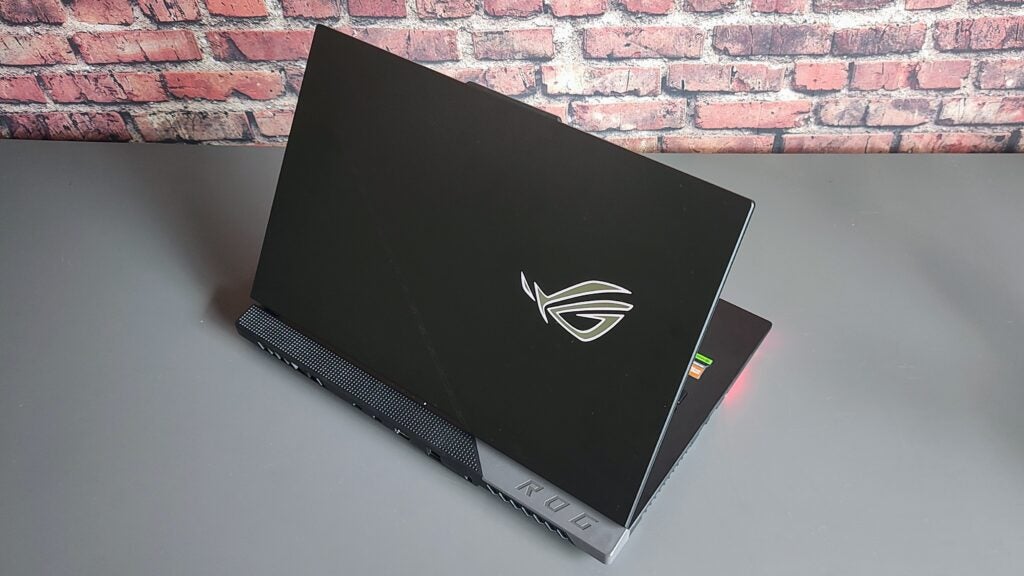
Again replicating the 7945HX model, the X3D proved an impressively quiet and cool performance even when running in Turbo mode under a heavy load. Maximum external temperatures never jumped above 37°, and fan noise never became annoying, peaking at 54dB(A).
On the subject of noise, I have read some users complaining of coil whine when running games, but this wasn’t something I experienced.
Latest deals
Should you buy it?
The fastest gaming laptop on the market
By adding the revised AMD Ryzen R9 7945HX3D processor to the 2023 ROG Strix Scar 17, Asus has made an already powerful gaming laptop even more powerful. The ROG Strix Scar 17 X3D is the most powerful gaming laptop money can buy.
The ROG Strix Scar 18 laptops have a larger, better display
The Ryzen R9 7945HX3D CPU and RTX 4090 GPU may be at the cutting edge of mobile gaming performance, but why put them in a laptop whose basic design is three years old? This silicon should be in the Strix Scar 18 rather than the 17.
Final Thoughts
Right now, you can get the RTX 4090 / 7945HX Strix Scar 17 for £3,300 (down from the usual price of £3,800) and the RTX 4080 / 7945HX model for £2,900. In the UK, the Strix Scar 17 X3D will have an RRP of £3,799, but I don’t know if it will be available with the cheaper RTX 4080 GPU.
There is no doubt that the latest version of AMD’s already impressive Dragon Range Ryzen R9 7945H CPU has moved the goalposts regarding gaming performance. The ROG Strix Scar 17 X3D can run games even faster than MSI’s monstrous Titan GT77 and leaves other RTX 4090 machines we’ve tested, like the Medion Erazer Beast X40, in its dust.
The outstanding performance does put into sharp relief the fact that the basic design of the ROG Strix Scar 17 is now getting rather long in the tooth and has been supplanted by the ROG Strix Scar 18 in the Asus ROG hierarchy. I’m sure there are good reasons why Asus has taken this route, but it still leaves the consumer paying top dollar for an old design of car, albeit one with a new engine.
How we test
Every laptop we review goes through a series of uniform checks designed to gauge key things, including build quality, performance, screen quality and battery life.
These include formal synthetic benchmarks and scripted tests, plus a series of real-world checks, such as how well it runs popular apps.
We use review machines as our main laptop for at least a week.
We test the performance via both benchmark tests and real-world use.
We test the screen with a colorimeter and real-world use.
We test the battery with a benchmark test and real-world use.
FAQs
Yes. The extra cache has a big impact on gaming performance because games require the CPU to process data very quickly, and extra cache memory is the key to making that happen.
No. Unlike Alienware, Asus ROG does not offer the option of a mechanical keyboard, but its chiclet design is still suitable for gaming.


